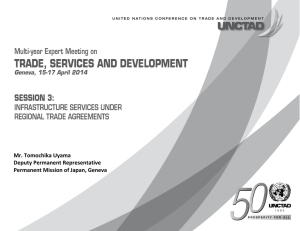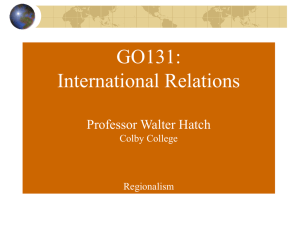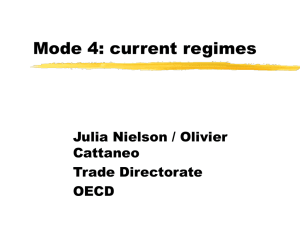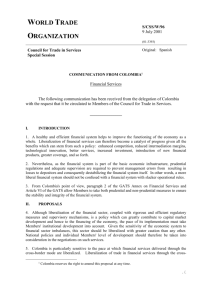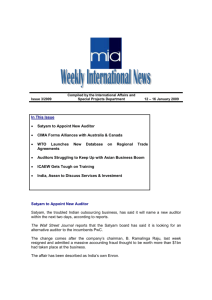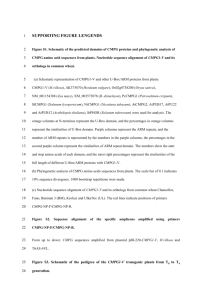Trade, Services and Development: The Regulatory and Institutional Dimension Multi‐Year Expert Meeting on
advertisement
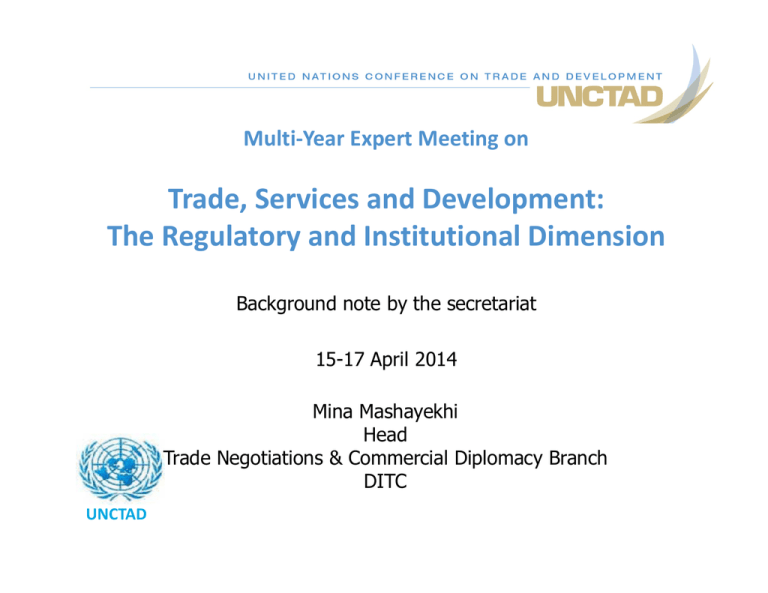
Multi‐Year Expert Meeting on Trade, Services and Development: The Regulatory and Institutional Dimension Background note by the secretariat 15-17 April 2014 Mina Mashayekhi Head Trade Negotiations & Commercial Diplomacy Branch DITC UNCTAD Trends in services sector Services and ISS play an important role in the economy • 66% of global output; ISS =14% of global services outputs (2010) • 71% of global employment; ISS =12% (2012 or latest available year) • 20% of global exports of goods & services ($4.4 trillion); ISS = 32% of global services exports ($1.4 trillion) (2012) • DCs account for 30% of total world commercial services exports & developed countries, for 67% • Transport is the most important (20% of services exports), then financial services (9%) and communications (2.5%) (2012) Share of ISS in total services exports by region, 2012 (percentage) Transport Communications Financial ISS Total Travel Other business services World 20.2 2.5 9.1 31.8 25.1 25.5 Developed countries 18.6 2.7 11.1 32.4 21.3 26.1 Transition economies 32.8 3.1 2.1 38.1 29.1 20.4 Developing countries 22.4 2.0 5.3 29.8 33.0 24.5 Developing Africa 27.2 4.5 3.4 35.1 43.9 10.7 Developing America 18.3 2.7 5.9 27.0 38.2 27.3 Developing Asia 22.6 1.7 5.4 29.8 31.2 25.4 Trade in infrastructure services sector Developing countries increased their share in world exports • Cross-border exports of ISS was $401 billion in DCs (29.8% of their total services exports) compared to $956.5 billion in developed countries (32.4% of their total services exports) (2012) • DCs’ share in global exports of ISS rose from 22.5% (2000) to 28.5% (2012) while developed countries went from 75% (2000) to 68% (2012) • DCs’ share in global exports is higher in transport (34%) and lower in financial services (18%) (2012) and grew more in transport (9.6%) and decreased in communications (5.4%) (2000-2012) • Major DC exporters: – – – Transport : Singapore (4.8% of world), Korea (43.6%) & China (4.4%) Communication: Kuwait (3.1%), China (1.6%) & India (1.5%) Financial: Singapore (4.9%), Hong Kong (China) (4.8%) & India (1.8%) DC share in world services exports by sector, 2000 and 2012 (percentage) Trade in infrastructure services sector Trade in ISS is important but less dynamic than other services sectors • ISS exports from DCs recover slowly since the crisis (slow growth of trade in manufactures, fragility of financial markets) – • • • Average growth rate over 2007-2012 of 5.6% for transport, 1.9% for communications & 7.1% for financial services as compared to 8.3% for total services Computer and information, construction and travel are more dynamic Developed countries recover even slower (average growth of 3.2% for total services) Asia represents 80% of DCs’ exports in transport and financial services Exports of selected services categories, 2007-2012 (2007=100) Developing countries Developed countries Trade in infrastructure services sector Mode 3 and mode 4 are important but more data needed • The bulk of US services exports is through commercial presence of foreign affiliates ($641 billion in 2012, 5 times cross-border exports) • Global FDI outflows ($1.4 trillion in 2009-2011) increasingly directed at services (69%), including ISS (31%) – DCs account for 12.5% of global outflows into ISS (2009-2011), up from 0.4% in 1990-1992 – DCs’ FDI outflows directed at financial services (15.4%), with small shares for transport, storage & communication (3.9%) and electricity, gas & water (1%) • Mode 4 is important for the provision of ISS and related professional and business services – Global remittance flows to developing countries increased 6.3% to $414 billion (2013), 75% of total global remittance flows ($550 billion) • The need to improve data availability in services, including in mode 3 and 4 – E.g. Siscoserv in Brazil - a national initiative to improve firm-level data collection and classification on services value-added based on a computerized system as a tool for the formulation, monitoring and assessment of services policies. Trade in infrastructure services sector Sectoral variation in ISS • Telecommunications revenues have increased 12% (2007-2011) to $1.8 trillion, 2.6% of global GDP (developments in ICT access/uptake) • Developing countries’ participation on telecommunications revenues increased from 26% to 30% (2007-2011) • In financial services, commercial banking revenues increased 1.3% (annual average between 2008-2012) to $3.5 trillion (4.2% increase estimated for 2013) • In transport, international seaborne trade volumes increased 4.3% (2012) with overcapacity keeping overall freight rates low Services under the Int’l Trading System Increasingly pursued under plurilateral & regional arrangements • Services (ie, the UR built-in agenda) did not receive priority attention under the Doha Round – Numerical benchmarks and formulas were proposed but not adopted (2005), plurilaterals, Signalling Conference (2008) – MC9 outcome (incl. operationalization of LDC services waiver) & post-Bali process towards “a clearly defined work programme” to be determined – Possible relevance of services to trade facilitation (transport & logistics) & e-commerce work: e.g., enhancing internet connectivity, access to info & telecom technologies, mobile telephony, electronically delivered software, cloud computing, the protection of confidential data and consumer protection • Plurilateral TISA negotiations by 23 countries (70% of global services trade) – 23 TISA participants = Australia, Canada, Chile, Colombia, Costa Rica, EU, Hong Kong, Iceland, Israel, Japan, Liechtenstein, Mexico, New Zealand, Norway, Pakistan, Panama, Paraguay, Peru, Korea, Switzerland, Turkey, the United States and Taiwan Province of China – Expected to build upon GATS approach to promote multilateralization and participation of new members – Seek to capture autonomous & preferential liberalization, including through Horizontal application of national treatment & non-application of MFN pending on critical mass – Estimates of TISA increasing bilateral exports in $78 billion but such estimates often do not factor existing RTAs among participants (e.g. Chile has services RTAs with 19 of the 23 TISA participants) => Need for careful examination of services RTAs Trends in services RTAs Services as a major feature of 21st century RTAs • RTAs increasingly aim at deep integration with strong regulatory focus, encompassing services, investment, competition policy, capital movement, IPR, GP, standards, labour and environment • 575 RTAs notified (July 2013), 379 in force & 129 notified under GATS Article V • Only six services RTAs notified before 2000 but over 100 notified since then • Since 1985, 60% of RTAs formed by developed countries and 55% of RTAs by DCs contain services Services in the post-1985 RTAs With developed countries Yes No Share Developed countries 7 5 58% Developing countries Latin America 22 2 92% Asia 17 1 94% Africa and Middle East 2 13 13% Transition economies 0 0 Total 41 16 72% Source: UNCTAD based on WTO data. With developing countries Yes No Share 55 35 61% 39 27 0 0 66 5 14 21 31 70 89% 66% 0% 0% 49% Total share 60% 90% 75% 6% 0% 55% Trends in services RTAs Mega regionals, North-South and South-South RTAs • Mega regionals enlarge the trade agenda with regulatory issues & could impact the MTS’s centrality & viability, unless results serve as building blocks to multilateralism • Trans-Pacific Partnership Agreement (TPP) to create a regional market among 12 countries with 40% of global GDP and 24% of global exports (Australia, Brunei, Chile, Canada, Japan, Malaysia, Mexico, NZ, Peru, Singapore, the United States & Viet Nam) • Transatlantic Trade and Investment Partnership (TTIP) would create the largest market with 50% of global GDP and 1/3 of global exports • North-South RTAs have had the effect of extending services liberalization in DCs (e.g. Cariforum-EU EPA, replacing preference based relationships) • South-South regional initiatives increasingly envisage “developmental integration” combining market opening with regulatory cooperation, productive capacity & infrastructure building – – – – – ASEAN economic community by 2015 China-ASEAN FTA with 1/3 of world population and 13% of global GDP Continental pan-African FTA by 2017 Greater Arab FTA MERCOSUR; Andean Community; Caribbean Common Market Liberalization of ISS under RTAs Regional liberalization of ISS • “Regulatory measures” may or may not act as trade barriers – Possible trade restrictive effects to be weighed against the legitimate public policy goals (e.g., information asymmetry, externalities, imperfect competition universal access) • Applied regulatory regime often more open than bound in GATS / RTAs – Applied level of “restrictiveness” is higher in professional services (mode 4) due to immigration regulations and licensing and qualifications – Restrictiveness is lower on financial services, although mode 1 tends to be more restrictive (reflecting the concern of allowing capital mobility) • Relevance of WTO discussion on Domestic Regulations – To ensure that qualification requirements, technical standards and licensing requirements do not constitute unnecessary barriers to trade while respecting right to regulate Average services trade restrictions index Overall Mode 1 Mode 3 Mode 4 Financial 22.3 32.4 21.5 . Professional 48.3 28.3 40.1 60.3 Telecommunications 26.7 - 26.7 - 31 28.6 31.8 - Transport Source: UNCTAD calculations based on the World Bank’s Services Trade Restrictions Index. Liberalization of ISS under RTAs RTAs commitments generally go beyond GATS • GATS openness (as per GATS commitments) are high in financial services (119 countries), telecommunications (108 countries), transport (38 countries in maritime freight) and low in energy • RTAs led to further liberalization of telecom & greatly increased commitments in transport subsectors (geographical proximity and bilateral relationships) but • Limited improvements in banking services (preferences may lead to arbitrage) Average indices of commitments under GATS and RTAs for all countries Source: UNCTAD calculations based on WTO dataset on services commitments in RTAs Liberalization of ISS under RTAs RTAs induce more liberalization on developing countries • RTAs induce more GATS+ commitments in DCs than in developed countries • Differences are explained by a higher level of GATS commitments from developed countries and by the asymmetric bargaining structure of North-South RTAs (e.g., commitment indices in US RTAs) • Liberalization can also be assessed by examining legislation that countries enact for their RTAs (e.g., Guatemala under CAFTA-DR) • “GATS ‒” may happen when existing GATS commitments were downgraded in RTAs (e.g., subsidies) but a cross-reference to GATS schedules neutralizes any GATS-minus provisions Average indices of commitments under GATS and RTAs Developing countries Developed countries Source: UNCTAD calculations based on WTO dataset on services commitments in RTAs Liberalization of ISS under RTAs North-South RTAs commitments appear to confirm liberalization patterns • In the Morocco – US FTA, Morocco: – made bindings in mode 1 (94 subsectors) and mode 3 (80 subsectors); – made full commitments in telecommunications (more than GATS); and – allowed US insurers to establish branches and to supply cross-border transport insurance • In the Bahrain – US FTA, Bahrain: – made full commitments (in GATS was limited to telecommunications); – on financial services committed to phase out local presence requirements for mode 1 and allowed US insurers to acquire new non-life insurance licences; • In Korea FTAs with EU and with US, Korea: – – – – allowed foreign providers to own 100% of some telecommunication services; opened transport insurance markets for foreign insurers; allowed foreign financial institutions to provide advisory services allowed foreign institutions to provide all financial services in mode 3 and pre-selected financial services in mode 1 (in the FTA with the US) Liberalization of ISS under RTAs South-South RTAs also achieved GATS-plus commitments in ISS • In ASEAN, GATS-plus were made on transport and energy and the equity limit on telecommunications was raised • MERCOSUR liberalizes on a positive list by 2015, with GATS-plus on telecommunications and going beyond GATS on transport • Andean Community adopted a negative list approach with some remaining non-conforming measures in transport and energy • COMESA, EAC and SADC identified ISS as a liberalization priority, with substantial GATS-plus opening on EAC and ongoing services negotiations in SADC to be completed by 2015 (focus on modes 3/4) Liberalization under the EAC and the GATS Sectors committed in EAC (out of 7) Subsectors committed in EAC (out of 140) % liberalized commitments in EAC % liberalized commitments in GATS Burundi 7 89 59 % 18 % Kenya 7 67 42 % 31 % Rwanda 7 105 74 % 6% United Republic of Tanzania 7 56 37 % ≤ 1% Uganda 7 102 72 % 7% Countries Source: P. Kruger (2011). Services negotiations under the tripartite agreement: issues to consider. Working Papers, 15 June, Trade Law Centre. Stellenbosch, South Africa Liberalization of ISS under RTAs Development implications of liberalization instruments need assessment • Negative list requires full knowledge of the measures in place in all sectors and detailed scheduling (to avoid inadvertent liberalization), while the positive list allows more flexibility, while both approaches may lead to the equivalent openness • Recent RTAs introduced new instruments for deeper liberalization – Commitments may be based on applied levels of market access – Stand-still requirements not allowing to decrease the conformity of the measure with respective obligations – “Ratchet” clause for automatic incorporation of further future measures – Horizontal application of national treatment to all sectors/modes – “Third-party MFN” to ensure a RTA party the best possible preferential treatment available from other RTA partners (could dissuade parties from engaging in ambitious market opening) • • Investor-State disputes may lead to a “regulatory chill” for fear of legal challenges Disciplines on State-owned enterprises to ensure “competitive neutrality” with private companies may limit regulatory space Regulatory disciplines under RTAs GATS+ disciplines on telecommunications (often based on GATS Reference Paper) • The Republic of Korea – EU FTA provide for non-discriminatory access to telecommunication services (basic and value added) • The ASEAN – Australia – New Zealand FTA included the new definition of facilities-based supplier and obligations to provide leased circuit services • The EU and the US agreed on the Trade Principles for ICT services, which may inform TTIP negotiations, including network access and use, cross-border information flows, use of spectrum and interconnection Emerging regulatory issues on telecommunications • Network neutrality is essential when broadband access providers manage data traffic to avoid congestion due to scarcity of spectrum • High wholesale prices for international mobile roaming, under the responsibility of regulatory authorities, require international cooperation • Privacy and security is critical for cloud computing where data may be stored in a different country Regulatory disciplines under RTAs GATS+ disciplines on financial services (often based on GATS Understanding on Commitments in Financial Services) • Concerns exist that standstill obligations limit future re-regulation • Concerns about financial product safety, unless adequately designed, derive from the obligation to allow new financial services by any foreign supplier through mode 3 • Concerns that mode 1 liberalization limits regulatory control and implies an open capital account, have lead to requirements of commercial establishment through subsidiaries and not branching Issues in financial regulatory reform • Ongoing financial regulatory reforms aim to minimize future crisis and mitigate costs by shifting the regulatory focus to macroprudential goals • Basel III reforms aim to strengthen bank capital and liquidity standards (not mandatory for DCs) • Prohibition of most proprietary trading for deposit-taking banks (“Volcker rule” in the US) • Steps towards a banking union in the EU Regulatory disciplines under RTAs Transport services • Focus on fair competition through access to essential facilities and prohibition of cross-subsidization • National maritime cabotage and air traffic rights are usually excluded • The WTO Agreement on Trade Facilitation affects trade in transport and logistic services, clarifying existing disciplines and introducing commitments on pre-arrival processing, authorised operators and expedited shipments Liberalization in professional services / mode 4 • In North-South RTAs commitments in mode 4 tends to be linked to mode 3 and limited to “key personnel” (Korea – EU FTA and ASEAN, Australia and New Zealand FTA) • Liberalization in mode 4 links to immigration and labour market policies Regulatory cooperation under RTAs Regulatory cooperation under RTAs are pursued to facilitate trade • More feasible among countries with supporting institutions and a similar level of development and regulatory preferences • Through measures facilitating temporary entry and stay, regulatory harmonisation, mutual recognition of qualifications – E.g., “European professional card” in the EU; “registered ASEAN professionals”; “Business Travel Card” in the Asia-Pacific Economic Cooperation Forum; • Greater emphasis on reducing regulatory discretion by promoting regulatory coherence and convergence in national standards – TPP proposes central coordination towards good regulatory practice and impact assessment of regulatory measures Regional cooperation ‐ Energy Energy cooperation centred on cross-border infrastructure & supply • ASEAN adopted the Plan of Action for Energy Cooperation 2010-2015 to harmonise regulations and technical specifications, enhance generation capacity, facilitate interconnection and cross-border trade, promote renewable energy and energy efficiency • China – ASEAN cooperative scheme focus on power grid connectivity and power trading • UNASUR and MERCOSUR focus on interconnection and transmission lines while the Andean Community focus on regulation with a view on the future interconnection system • Central America focus on regional infrastructure for interconnection and transmission and towards a regional electricity market • SADC seeks interconnection for cross-border transmission to implement the Protocol on Energy and increase energy access Regional cooperation ‐ Transport Transport cooperation on regional networks and cross-border connectivity • ASEAN Framework Agreement on the Facilitation of Inter-State Transport expands market access, sets regional regulation and harmonises road transport requirements and mutual recognition of vehicle inspection certificates • In China – ASEAN cooperative scheme, 6 member countries share costs of building infrastructure • Andean Community develops regional initiatives on transport and trade facilitation, UNASUR focus on road infrastructure and border crossings • MERCOSUR supports road and railroad infrastructure, Central America supports the development of road transport and connection • COMESA-EAC-SADC tripartite initiative induces convergence of sub regional transport policies and institutions; Regional transport corridors in Africa are central and require quality logistics services and one-stop border posts Regional cooperation ‐ Telecommunications Telecommunication cooperation focus on interconnection, spectrum management and broadband infrastructure • ASEAN, with the ICT Master Plan 2015, enhances cooperation on broadband, information security and ICT adoption by SME towards universal access • Andean Community promotes integration of telecommunications including roaming services in border areas and broadband development • Mesoamerican Project develops the Mesoamerican Information Highway, a technological platform to improve broadband connectivity • Africa (New Partnership for Africa’s Development e-Africa Programme) develops broadband infrastructure through existing and planned submarine and terrestrial cables Regional cooperation – Financial services Regional cooperation addressed the creation of regional financial infrastructure and institutions to support regional regulation and integration of financial systems • Establishment of West African Monetary Zone payment system to prepare for a single currency for the region • Single Euro Payments Area seeks efficiency in cross-border payments • Through Chiang Mai Initiative Multilateralization, ASEAN, China, Japan and Korea established a liquidity risk-sharing arrangement to reduce the risk of financial crisis; • Latin America, cooperation pursued to channel resources towards economic development, created the Bank of the South, the Common Reserve Fund of the South and the monetary unit of the South. Conclusions • • • • • • Services RTAs (including future Mega RTAs) become a salient feature of the ITS & driven by large countries with competitive services export capacity Need to assess how developing countries participation in RTAs can be coordinated with national regulations to maximize benefits of ISS Innovative SDT under RTAs is important for DCs to build competitive services, participate in GVC and strengthen regulatory and institutional capacity Regional cooperation in ISS can facilitate intraregional trade, accessing markets and enhancing regional infrastructure networks Regional liberalization and cooperation in ISS, coordinated with local policies and regulations, can contribute to developmental integration UNCTAD’s comprehensive work on services supports DCs’ efforts towards developmental integration through services development and trade Thank You. UNCTAD
